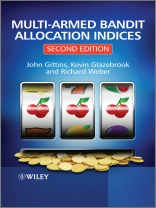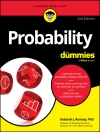In 1989 the first edition of this book set out Gittins’ pioneering
index solution to the multi-armed bandit problem and his subsequent
investigation of a wide of sequential resource allocation and
stochastic scheduling problems. Since then there has been a
remarkable flowering of new insights, generalizations and
applications, to which Glazebrook and Weber have made major
contributions.
This second edition brings the story up to date. There are new
chapters on the achievable region approach to stochastic
optimization problems, the construction of performance bounds for
suboptimal policies, Whittle’s restless bandits, and the use of
Lagrangian relaxation in the construction and evaluation of index
policies. Some of the many varied proofs of the index theorem are
discussed along with the insights that they provide. Many
contemporary applications are surveyed, and over 150 new references
are included.
Over the past 40 years the Gittins index has helped
theoreticians and practitioners to address a huge variety of
problems within chemometrics, economics, engineering, numerical
analysis, operational research, probability, statistics and website
design. This new edition will be an important resource for others
wishing to use this approach.
表中的内容
Foreword.
Foreword to the first edition.
Preface.
Preface to the first edition.
1 Introduction or Exploration.
Exercises.
2 Main Ideas: Gittins Index.
2.1 Introduction.
2.2 Decision processes.
2.3 Simple families of alternative bandit processes.
2.4 Dynamic programming.
2.5 Gittins index theorem.
2.6 Gittins index.
2.7 Proof of the index theorem by interchanging bandit
portions.
2.8 Continuous-time bandit processes.
2.9 Proof of the index theorem by induction and interchange
argument.
2.10 Calculation of Gittins indices.
2.11 Monotonicity conditions.
2.12 History of the index theorem.
2.13 Some decision process theory.
Exercises.
3 Necessary Assumptions for Indices.
3.1 Introduction.
3.2 Jobs.
3.3 Continuous-time jobs.
3.4 Necessary assumptions.
3.5 Beyond the necessary assumptions.
Exercises.
4 Superprocesses, Precedence Constraints and
Arrivals.
4.1 Introduction.
4.2 Bandit superprocesses.
4.3 The index theorem for superprocesses.
4.4 Stoppable bandit processes.
4.5 Proof of the index theorem by freezing and promotion
rules.
4.6 The index theorem for jobs with precedence constraints.
4.7 Precedence constraints forming an out-forest.
4.8 Bandit processes with arrivals.
4.9 Tax problems.
4.10 Near optimality of nearly index policies.
Exercises.
5 The Achievable Region Methodology.
5.1 Introduction.
5.2 A simple example.
5.3 Proof of the index theorem by greedy algorithm.
5.4 Generalized conservation laws and indexable systems.
5.5 Performance bounds for policies for branching bandits.
5.6 Job selection and scheduling problems.
5.7 Multi-armed bandits on parallel machines.
Exercises.
6 Restless Bandits and Lagrangian Relaxation.
6.1 Introduction.
6.2 Restless bandits.
6.3 Whittle indices for restless bandits.
6.4 Asymptotic optimality.
6.5 Monotone policies and simple proofs of indexability.
6.6 Applications to multi-class queuing systems.
6.7 Performance bounds for the Whittle index policy.
6.8 Indices for more general resource configurations.
Exercises.
7 Multi-Population Random Sampling (Theory).
7.1 Introduction.
7.2 Jobs and targets.
7.3 Use of monotonicity properties.
7.4 General methods of calculation: use of invariance
properties.
7.5 Random sampling times.
7.6 Brownian reward processes.
7.7 Asymptotically normal reward processes.
7.8 Diffusion bandits.
Exercises.
8 Multi-Population Random Sampling (Calculations).
8.1 Introduction.
8.2 Normal reward processes (known variance).
8.3 Normal reward processes (mean and variance both
unknown).
8.4 Bernoulli reward processes.
8.5 Exponential reward processes.
8.6 Exponential target process.
8.7 Bernoulli/exponential target process.
Exercises.
9 Further Exploitation.
9.1 Introduction.
9.2 Website morphing.
9.3 Economics.
9.4 Value of information.
9.5 More on job-scheduling problems.
9.6 Military applications.
References.
Tables.
Index.
关于作者
John Gittins, Statistics Department, University of Oxford, UK
Kevin Glazebrook, Department of Management Science, Lancaster University, UK
Richard Weber, Statistical Laboratory, University of Cambridge, UK












